Building Your Versatile Galactic Arena
As a fervent enthusiast of Star Wars and miniature gaming, we know that the battleground is as crucial as the heroes who grace it. The terrain in Star Wars Shatterpoint isn’t just a passive observer; it’s an active participant. It can provide cover, create chokepoints, and offer countless tactical advantages. With a dash of creativity and a sprinkle of strategy, the terrain becomes an ally in your quest for victory.
In this series, we aim to show you how to make the most of the terrain included in Star Wars Shatterpoint. From understanding the rules to crafting thrilling battlefields, we’re diving deep into the art of terrain for casual players and competitive hobbyists. We’ll explore the game rules, the do’s and don’ts, and how to bring the Star Wars universe to life through your tabletop battlefield.
Let’s strap on our blasters, ignite our lightsabers, and venture into Star Wars Shatterpoint terrain.
Terrain Rules
Understanding the rules and concepts related to terrain is critical for creating immersive and strategic gaming experiences. Here’s a summary of the fundamental terrain rules that can affect your decision for placement and builds:
Range Tools and Movement Tools
The game uses two types of measurement tools: range tools and movement tools. Players should only consider horizontal distance when measuring distances between objects, disregarding the vertical distance between objects. Vertical space is primarily used to determine the elevation of terrain.
Range Tools
Range tools are employed for measuring distances related to attacks, actions, abilities, and movement resulting from Pushes, Pulls, and Places. There are five range tools, each corresponding to specific ranges from 1 to 5. Range 1 is determined using the width of any range tool or either end of the Shove tool.
Movement Tools
Movement tools measure distances for character movement, like advancing, dashing, jumping, and climbing. “Advance” and “Dash” are the two movement tools available for these measurements.
Object Proximity
When an effect specifies that an object or terrain feature must be within a certain distance of another object or terrain feature, it’s considered within that distance if any portion of it is within the specified length of any other object or terrain feature. Units are considered within a space if any character in the Unit is within that distance.
Terrain Modularity
The Shatterpoint terrain system is designed with modularity, offering a diverse range of components that can be mixed, matched, and reconfigured to create various battlefield layouts. The modular nature of Shatterpoint’s terrain allows players to exercise creativity and adjustability in assembling the battlefield, resulting in a dynamic and ever-changing gaming environment. Here’s how the Shatterpoint terrain takes advantage of modularity:
-
Mix-and-Match Components: The terrain components, such as gantries, towers, sheds, vents, crates, ladders, and railings, are designed to be interchanged and combined in multiple ways. You can mix and match these elements to create distinctive staging, adjusting the battlefield’s layout to suit their preferences or specific missions (as of writing this, only two mission packs are out).
-
Reconfiguration Possibilities: you can easily reconfigure the layout between games. This flexibility enables quick adjustments, fostering an evolving battlefield that challenges players to adapt their strategies.
-
Customization and Personalization: You have the freedom to personalize your gaming experience. Experiment with different arrangements and terrain combinations, creating battlefields tailored to your or your squad’s playstyle, mission objectives, or thematic preferences.
-
Scalability and Expansion: The modularity of the terrain allows for scalability and expansion. Additional terrain packs or sets can be seamlessly integrated, providing more options for diversifying the table setup and adding complexity to gameplay.
-
Terrain Diversity: The modular terrain’s elements, with varying shapes, sizes, and elevation options, enable the creation of multi-dimensional battlefields. This diversity offers a rich tapestry for tactical gameplay, promoting strategic decisions and varied approaches to different missions.
-
Assembly and Versatility: The modular terrain components are designed for easy assembly and offer versatility in their creation. Will you put a radar dish on the shed? Will you put the second level on your towers? Your terrain will not be like any other Shatterpoint player, creating a unique setup and design you created.
Laying Out the Battlefield
The standard battlefield size of 36″ x 36″ allows a lot of room to balance challenge and maneuverability. We will discuss the terrain included in the core box set and add additional options with the available expansions. Mix and match, stack and scatter, combine gantries with tech sheds, and give your battlefield character. Create elevations that allow characters to climb and jump, adding a layer of complexity to your battles.
In our core box example setup, you utilize the Tech shed (R), Vent Building (S), two towers (Q), five complete ladders (two 4x and three 2x), and three gantries (one 6x and two 3x).
Gantries
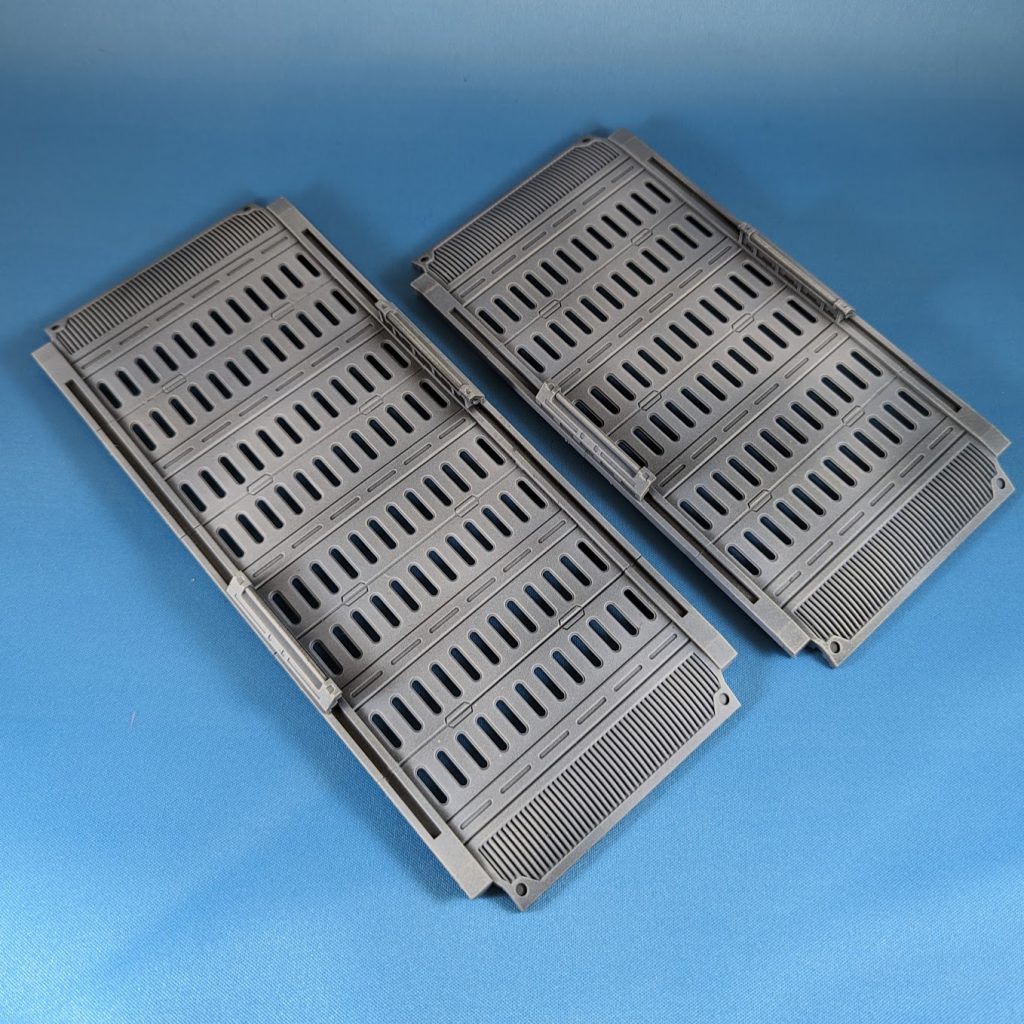
The gantries are the heart of your battlefield, providing verticality and cover. Place the gantry end pieces and centerpieces to create elevated walkways and platforms. These gantries offer opportunities for characters to climb and jump while also providing cover from ranged attacks. Set them in a way that allows characters to move between them and create tactical chokepoints. Ensure that characters have access to the gantries from various points on the battlefield.
Tech Shed
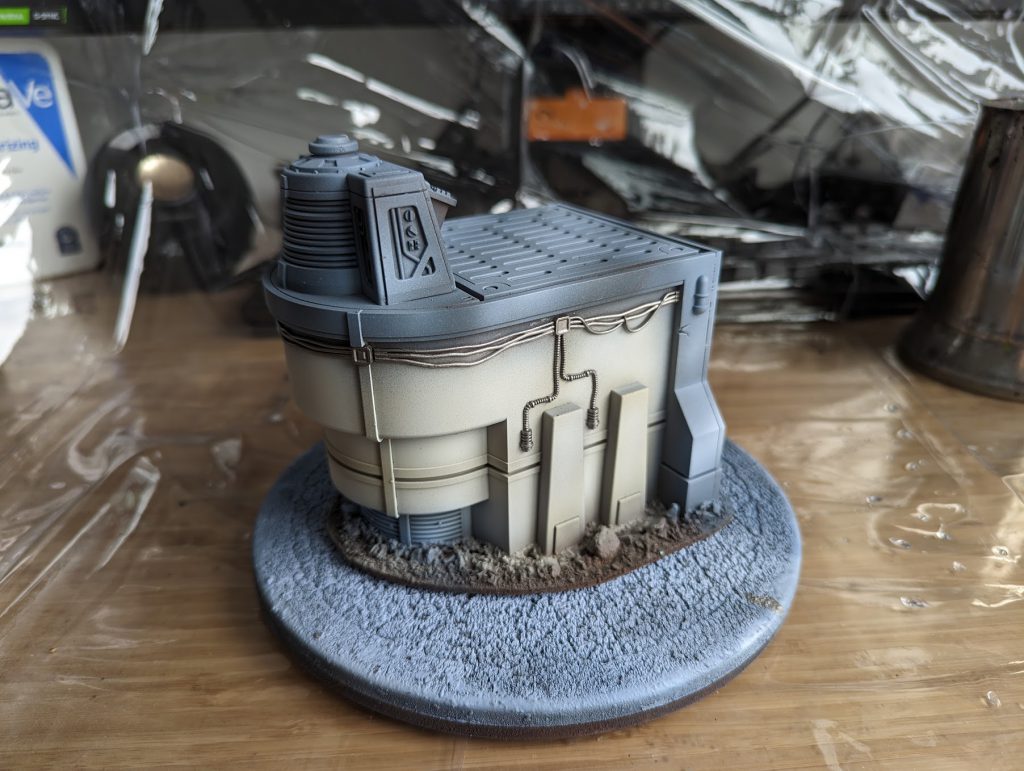
Position it strategically to add a thematic and functional element to your setup. Characters can take cover alongside, use it as an objective token center, and create a location for the gantries to come together. The tech shed has three sides that can connect to the gantry system. Place it in a way that makes it accessible from different angles, enhancing the adaptability of your battlefield.
Towers
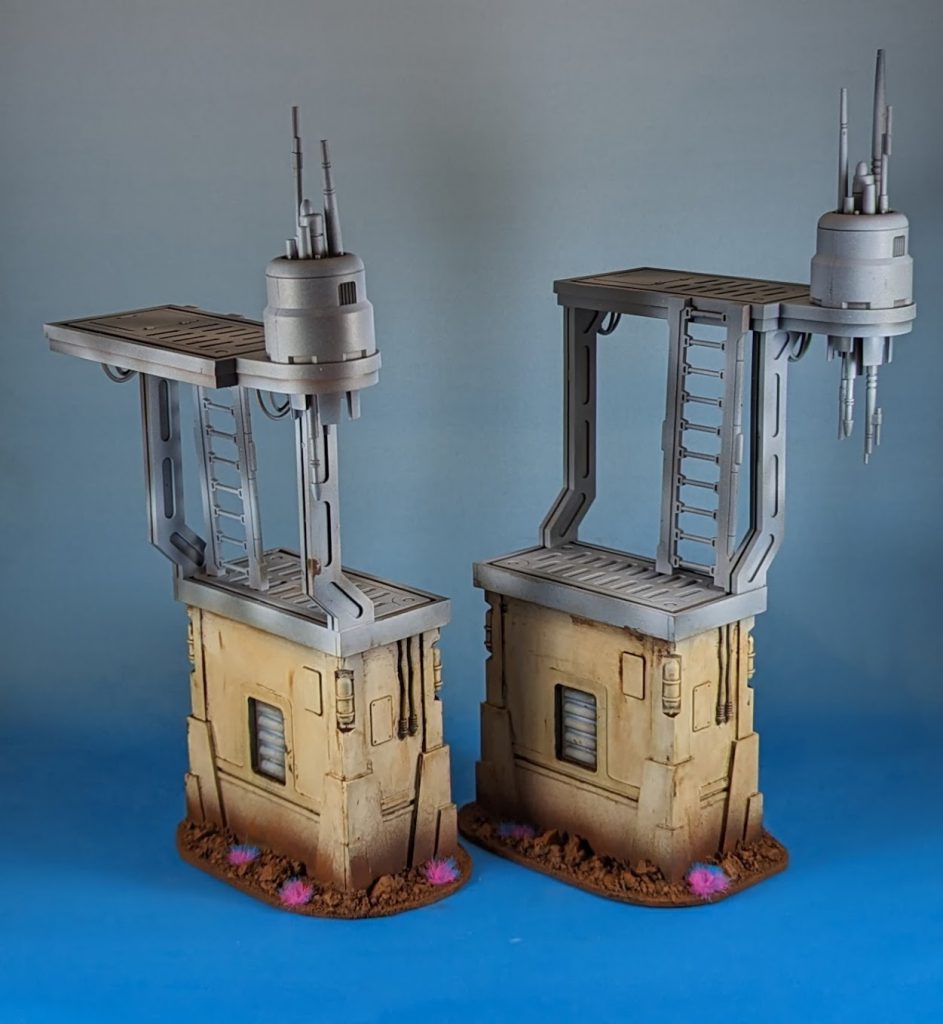
The tower base, top floor, and supports create a vertical element to your battlefield. Create multiple towers to form elevated vantage points for characters. Towers can be used for sniping, providing clear LOS to different parts of the battlefield. These can also serve as objectives. Position them to create a sense of height and give characters attractive movement options.
Vent Building

The vent building is the most complex out of the core box set. It can provide cover for bot and mid positions. Like the tech shed, it can connect three sides to the gantry system, with the front connection substantially wider. This could allow for a gantry connection and a ladder position.
Shatterpoint Blueprints
Embracing this versatility, myriad options await. Below, we present three diverse battlefield maps, each a unique arena for engaging in the epic struggle to secure the galaxy’s fate in Star Wars Shatterpoint.
Introducing Aurek

Terrain Placement and Objective Tokens
The Aurek terrain map was introduced on the Core box set cover in June 2023. The Aurek map covers three of the possible nine objective token locations. The ladders are spread out symmetrically to allow for access to the three possible elevations (Bot, Mid, Top).
The central point is on the large gantry walkway, creating high-stakes maneuverability with little cover other than the vent building top.
Ingress Points

The Aurek map layout is nearly symmetrical; the south player position has a slight favor when it comes to ingress points. Nabbing the south position as the first player makes the initial five attack dice roll off critical. They are giving that an advantage of distance by at least a dash tool because a ladder is on the southern gantry entry to the mid-center position.
Artistic Liberties
A wonderful thing about Star Wars Shatterpoint terrain is the decisions you can make. In our map examples, we stick with 2-3 piece gantry systems and light on the add-ons. However, towers can get dishes and attachments, some consoles can be added onto the shed, you can create long ladders, and you can build a short gantry and a long one.
In the core set assembly instructions for the Tower (Q), it is noted that two columns are required for stability (Q07 & Q06). However, one of these columns is noticeably absent from the provided finished image, even though the instructions imply that the attached ladder would serve as support. We strongly recommend including the additional column as referenced in the instructions.
However, our takeaway is the image may only be for marketing purposes, not instructions for map creation.
Symmetry or No Symmetry?
There has been some debate regarding whether your battlefield should be symmetrical or feature a unique and random setup on each side. Since no two squads play the same way, achieving a perfectly balanced table layout can be easily disrupted by characters with jetpacks and Jedi jumping abilities.
It’s often best to discuss with your gaming partner before deciding how you want your battlefield to appear and function. This ensures the environment aligns with your preferred playstyle and enhances your gaming experience.
High Ground Terrain Pack
The Array is the centerpiece of the High Ground expansion with built-in ladders; you also get two towers, two gantries (3x), and eight ladders. We have seen some alternative builds for the second set of towers. Not adding the ‘tops’ to create a mid-walkway gantry meeting point has been a popular option. In the following map, however, we stick to the assembly instructions. The High Ground Terrain Pack can be found here.
Introducing Besh
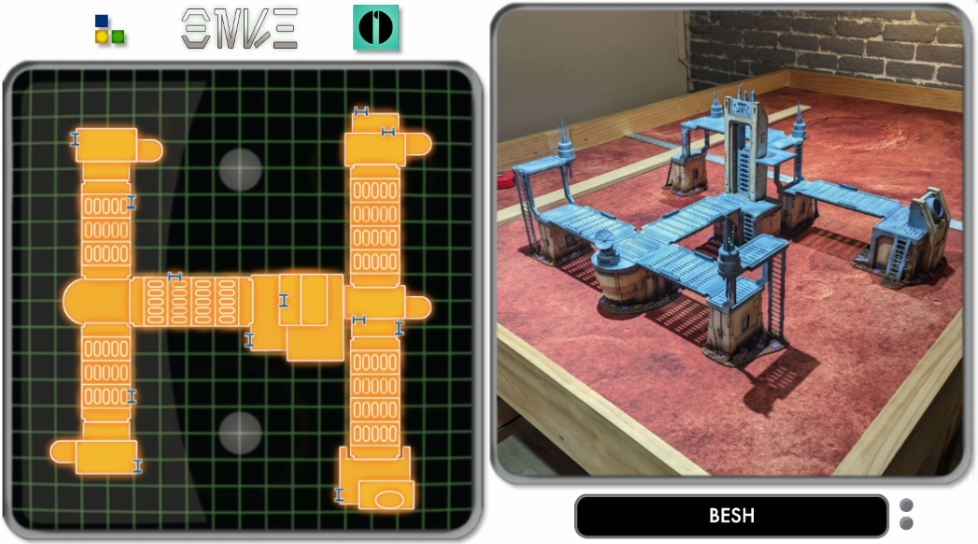
Terrain Placement and Objective Tokens
The Besh terrain map was created using the core set and the High Ground Terrain expansion. The Besh map covers seven of the possible nine objective token locations. Ladder locations are abundant throughout the map, with the most clustered near the center of the Array to allow easier access to the center point. The Array will also provide some cover from the eastern points if a sniper/longshot holds them down.
This map features the northeast objective point on top elevation and should be noted for those squads that do not have jet packs or force jumps. It will make the ladders and choice of points you try to capture and hold down very important.
With many more gantries on this map, positioning will occur on the mid-ground more often. It is worth getting acquainted intimately with the under/over gantry covering.
Gantries and Line of Sight
- Clear Line of Sight: Gantries typically offer a clear line of sight for characters positioned on or beneath them. Characters on a gantry have an unobstructed view of the battlefield, allowing them to target and engage enemies easily. Similarly, characters located beneath the gantries may have unobstructed sightlines across the terrain.
- Cover: Depending on the design and placement of the gantries, they may also provide partial cover. This cover will make it more challenging for characters to be targeted by ranged attacks, particularly when adversaries are positioned below the gantries. For a character to gain cover, they must have one or more hunker tokens; the defending character cannot be within range 1 on the same elevation straight line of sight.
- Elevation Advantage: Characters standing on gantries have an elevation advantage, granting a better view and broader line of sight across the battlefield. This elevation might provide a more precise line of sight, increased range, and strategic superiority, especially when targeting lower-ground characters.
- Tactical Considerations: The use of gantries can significantly impact tactical decisions. Characters strategically positioned on or beneath gantries can benefit from better visibility for ranged attacks or utilize them for cover and positional advantage.
*Note: A Unit loses all its Hunker tokens at the start of its activation or when a character in that Unit becomes Engaged. A Unit that is Engaged cannot gain or have Hunker tokens.
Take Cover Terrain Pack
The Take Cover Terrain Pack includes an abundance of cover. You receive a generator, large and small rocks, a swoop bike, and a Gonk droid! All of these can be used as scatter terrain, and the larger pieces can create cover. The pack also adds a tech shed and a few more ladders. The Take Cover Terrain pack can be found here.
Introducing Cresh

Terrain Placement and Objective Tokens
We wanted to give an example of an asymmetrical map. This map will include the core set, High Ground, and Take Cover terrain packs. Utilizing the Shed, Vent building, and gantries to create a walkway through 4 points, creating more incentive to not live on the ground. Due to ladder placement and scalability, two northern points on TOP elevation will make planning critical to holding these points.
Choosing a Side
The southern starting position will give those on the ground an advantage, with two south points on the ground. The northern starting player will have some benefits if they can scale to the Top using a squad like the Mandalorians.
Shatterpoint Terrain
It’s evident that the terrain is more than just the backdrop to your battles—it’s the strategic canvas where your epic clashes unfold. Terrain placement isn’t just about arranging pieces; it’s about orchestrating a dynamic environment and sculpting a stage for the heroes and villains of your narrative. With its endless possibilities and mix-and-match prowess, the modular terrain empowers your creativity and adds an ever-evolving layer to the game.
As you venture into your Shatterpoint battles, armed with the wisdom of crafting battlefields and leveraging every terrain piece, I encourage you to let your imagination run wild.
May the Force and the terrain be with us as we create epic battles and unforgettable stories in a galaxy far, far away.
This article is part of a paid partnership with Atomic Mass Games
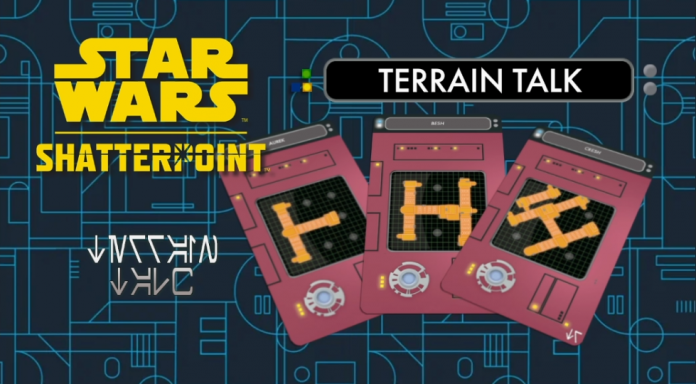


You must be logged in to post a comment.